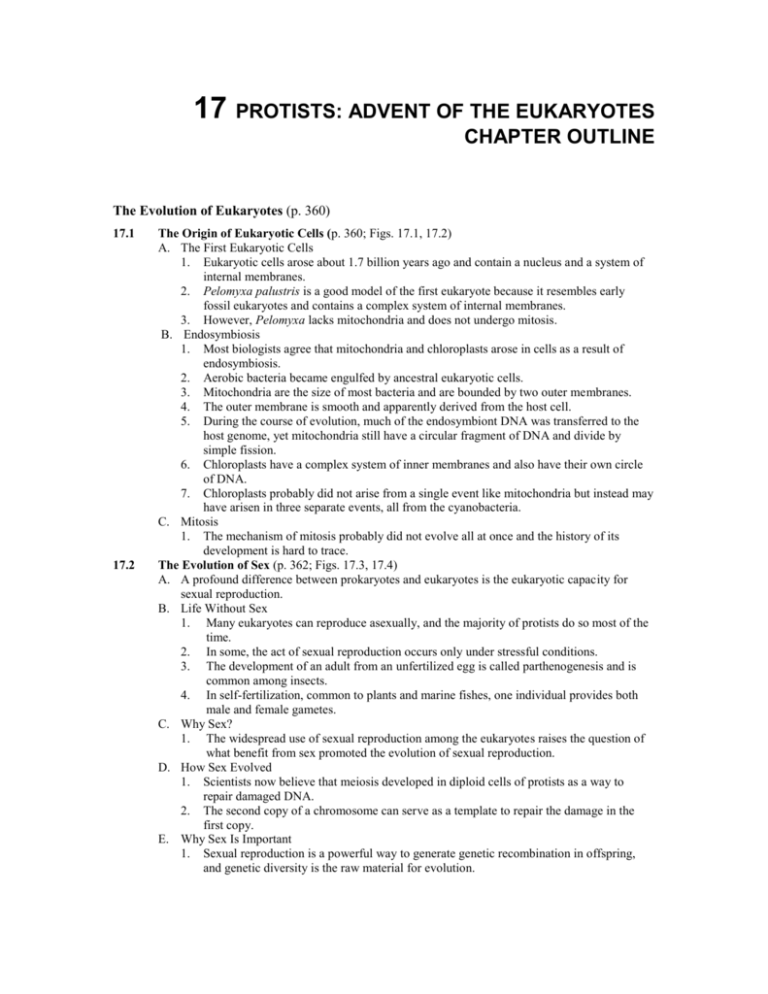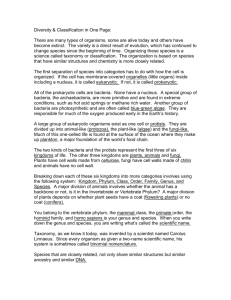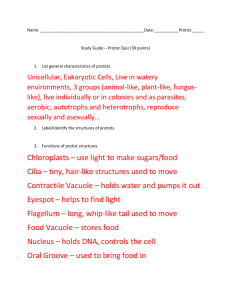17 PROTISTS: ADVENT OF THE EUKARYOTES
advertisement

17 PROTISTS: ADVENT OF THE EUKARYOTES CHAPTER OUTLINE The Evolution of Eukaryotes (p. 360) 17.1 17.2 The Origin of Eukaryotic Cells (p. 360; Figs. 17.1, 17.2) A. The First Eukaryotic Cells 1. Eukaryotic cells arose about 1.7 billion years ago and contain a nucleus and a system of internal membranes. 2. Pelomyxa palustris is a good model of the first eukaryote because it resembles early fossil eukaryotes and contains a complex system of internal membranes. 3. However, Pelomyxa lacks mitochondria and does not undergo mitosis. B. Endosymbiosis 1. Most biologists agree that mitochondria and chloroplasts arose in cells as a result of endosymbiosis. 2. Aerobic bacteria became engulfed by ancestral eukaryotic cells. 3. Mitochondria are the size of most bacteria and are bounded by two outer membranes. 4. The outer membrane is smooth and apparently derived from the host cell. 5. During the course of evolution, much of the endosymbiont DNA was transferred to the host genome, yet mitochondria still have a circular fragment of DNA and divide by simple fission. 6. Chloroplasts have a complex system of inner membranes and also have their own circle of DNA. 7. Chloroplasts probably did not arise from a single event like mitochondria but instead may have arisen in three separate events, all from the cyanobacteria. C. Mitosis 1. The mechanism of mitosis probably did not evolve all at once and the history of its development is hard to trace. The Evolution of Sex (p. 362; Figs. 17.3, 17.4) A. A profound difference between prokaryotes and eukaryotes is the eukaryotic capacity for sexual reproduction. B. Life Without Sex 1. Many eukaryotes can reproduce asexually, and the majority of protists do so most of the time. 2. In some, the act of sexual reproduction occurs only under stressful conditions. 3. The development of an adult from an unfertilized egg is called parthenogenesis and is common among insects. 4. In self-fertilization, common to plants and marine fishes, one individual provides both male and female gametes. C. Why Sex? 1. The widespread use of sexual reproduction among the eukaryotes raises the question of what benefit from sex promoted the evolution of sexual reproduction. D. How Sex Evolved 1. Scientists now believe that meiosis developed in diploid cells of protists as a way to repair damaged DNA. 2. The second copy of a chromosome can serve as a template to repair the damage in the first copy. E. Why Sex Is Important 1. Sexual reproduction is a powerful way to generate genetic recombination in offspring, and genetic diversity is the raw material for evolution. F. Sexual Life Cycles 1. The production of haploid gametes by meiosis, followed by the union of two gametes in sexual reproduction, is called the sexual life cycle. 2. Three major types of sexual life cycles exist in eukaryotes: zygotic meiosis, gametic meiosis, and sporic meiosis, the last of which occurs in plants and causes an alternation of generations. The Protists (p. 364) 17.3 17.4 17.5 17.6 General Biology of the Protists, The Most Ancient Eukaryotes (p. 364; Figs. 17.5, 17.6) A. The Cell Surface 1. All protists have plasma membranes but some also have cell walls and silica shells. B. Locomotor Organelles 1. Protists move by flagella or pseudopodial movement, while some propel themselves with cilia. C. Cyst Formation 1. Some protists survive inhospitable conditions by forming cysts. D. Nutrition 1. Protists vary widely in their modes of nutrition. 2. Among the protists are phototrophs, phagotrophs, and osmotrophs. E. Reproduction 1. A variety of modes of asexual reproduction are seen among protists, including spore formation, budding, and schizogony; sexual reproduction occurs mostly only during times of stress. F. Multicellularity 1. The evolution of multicellularity solved the problem of surface area-to-volume ratios that occur as cells increase in size. 2. The key advantage to multicellularity is that it allows for specialization in distinct types of tissues. 3. A colonial organism is a permanent collection of cells that show little or no integration of cellular activities. 4. Examples include the green alga, Volvox, and other protists. 5. An aggregation is a transient collection of cells that come together and later separate, such as cellular slime molds; the slime mold aggregation increases the chances that food will be found. 6. When activities of individual cells are coordinated, true multicellularity occurs. 7. Multicellularity is one characteristic that distinguishes the eukaryotes from the prokaryotes. 8. In multicellular organisms, individuals are composed of cells that interact with one another and coordinate their activities. Classifying the Protists (p. 366; Figs. 17.7, 17.8; Table 17.1) A. Protists are the most diverse group of eukaryotes. B. As a matter of convenience, protists are grouped into one kingdom. C. Molecular data indicates that 12 of the 17 major protist phyla can be assigned to 7 clades. D. Five phyla cannot yet be placed on the protist phylogenetic tree. E. The relationships among the protists will likely be revised as more information becomes available. The Base of the Protist Tree (p. 368) A. Diplomonads and parabasalids resemble early eukaryotes. B. Both groups have flagella but lack mitochondria. A Diverse Kingdom (p. 368; Figs. 17.9–17.15) A. Seven protist phyla are clustered into three clades: Euglenozoa (phylum Euglenozoa), Stramenopila (phylum Phaeophyta, phylum Chrysophyta, and phylum Oomycota), and Alveolata (phylum Ciliophora, phylum Pyrrhophyta, and phylum Apicomplexa). B. Euglenozoa Are Free-Living Protists with Anterior Flagella 1. The phylum Euglenozoa includes the euglenoids and trypanosomes. 2. Euglenoids like Euglena are freshwater protists with two flagella. 3. 4. 5. 6. 17.7 17.8 A light-sensitive stigma helps the photosynthetic euglenoids move toward the light. Reproduction is by mitosis; sexual reproduction is not known for this group. Trypanosomes have a single mitochondrion that contains two circles of DNA. Some trypanosomes are important human pathogens, including those that cause sleeping sickness. C. Stramenopila Are Protists with Fine Hairs 1. Brown algae (phylum Phaeophyta) contain the longest, fastest-growing, most photosynthetically productive living organisms, the giant kelp. 2. Brown algae are all multicellular and almost all marine; they often contain internal plumbing similar to that of land plants. 3. The life cycle employs an alternation of generations; the large individuals are diploid. 4. The diatoms (phylum Chrysophyta) are photosynthetic unicellular protists with a double shell of silica and are abundant in both oceans and freshwater habitats. 5. Shells of fossil diatoms form thick deposits and are mined as “diatomaceous earth” used to make abrasives. 6. Water molds (phylum Oomycota) are important plant pathogens and live in moist environments. D. Alveolata Are Protists with Submembrane Vesicles 1. Members of the phylum Ciliophora might well be placed in their own kingdom. 2. They have complex internal structures and are typified by Paramecium. 3. They usually reproduce asexually by fission, but they can also undergo a form of sexual reproduction called conjugation. 4. Dinoflagellates (phylum Pyrrhophyta) are unicellular photosynthetic protists, most with two flagella of unequal length. 5. Most dinoflagellates occur in the marine environment where they produce both luminescence and red tides. 6. A stiff outer coating of cellulose and silica give these protists unique shapes. 7. Sporozoans (phylum Apicomplexa) are spore-forming unicellular parasites of animals. 8. Sporozoans have complex life cycles involving both asexual and sexual reproduction. 9. The sporozoan Plasmodium is responsible for causing malaria. The Road to Plants (p. 371; Figs. 17.16, 17.17, 17.18) A. The red and green algae are included on a lineage that led to the evolution of plants. B. Rhodophyta Are Ancient Photosynthesizers 1. Red algae (phylum Rhodophyta) possess red pigments called phycobilins. 2. There are 4,000 species of red algae, and most are multicellular and marine. 3. Red algae have complex life cycles usually involving an alternation of generations. 4. Since red algae do not have flagella or centrioles, they may be one of the most ancient groups of eukaryotes. C. Chlorophyta Are the Direct Ancestors of Plants 1. Green algae are members of the Chlorophyta and are an extremely varied group containing the ancestor of terrestrial plants. 2. Most green algae are unicellular and microscopic, but others (sea lettuce) are large and multicellular. 3. Some, like Volvox, are colonial. The Road to Animals (p. 373; Fig. 17.19) A. Protists called choanoflagellates were likely the ancestors of animals. B. Choanoflagellida Are the Direct Ancestors of Animals 1. Choanoflagellates (phylum Choanozoa) are unicellular, heterotrophic protists with a long flagellum. 2. The whipping motion of the flagellum allows choanoflagellates to draw water in and filter-feed on bacteria; this same type of filtering is found in sponges, primitive animals. 3. Colonies can form that look very much like freshwater sponges. 4. Also, choanoflagellates and sponges have molecular similarities. 17.9 “Not Yet Located on the Protist Phylogenetic Tree” (p. 373; Figs. 17.20–17.25) A. Five phyla cannot yet be located on the protist phylogenetic tree. B. These five groups use their cytoplasm to aid movement. C. Amoebas 1. Amoebas (phylum Rhizopoda) move from one place to another by cytoplasmic extensions known as pseudopodia. 2. Amoebas lack meiosis and sexual reproduction and reproduce only by simple fission. D. Forams 1. These members of the phylum Foraminifera have rigid shells and move by cytoplasmic streaming. 2. Forams are marine and have shells called tests that are often brilliantly colored. 3. Thin, cytoplasmic projections called podia radiate out through pores in the shells. 4. Forams have a complex life cycle involving an alternation of generations. E. Radiolarians 1. Radiolarians (phylum Actinopoda) are amoeboid cells with glassy skeletons and needlelike pseudopods. F. Cellular Slide Molds 1. Cellular slime molds (phylum Acrasiomycota) are closely related to amoebas and form complex associations called slugs when under stress. 2. Once in a new habitat, the slug can differentiate to become a spore-forming structure. G. Plasmodial Slime Molds 1. Plasmodial slime molds (phylum Myxomycota) are a group of 500 species that stream along as a plasmodium, a nonwalled multinucleate mass of cytoplasm. 2. Spore-producing structures are formed under stressful conditions, and the spores germinate when favorable conditions return.







